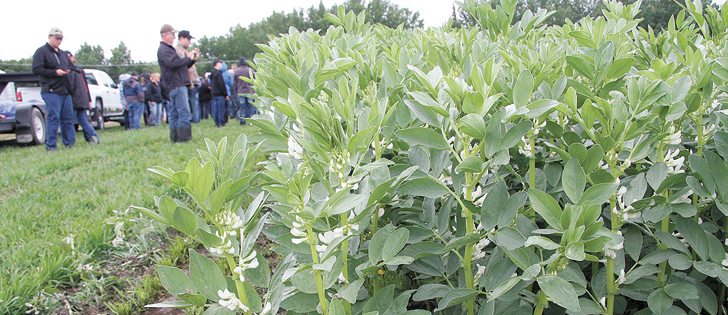SWIFT CURRENT, Sask. — Other pulses aren’t enjoying their wet feet, but fababeans thrive in the wet weather that southwestern Sask-atchewan has had this year.
The crop isn’t typically grown in the region, which tends to be drier than other parts of the province, but demonstration plots at the Wheatland Conservation Area show healthy stands.
“It really likes the rain quite a bit,” said Dale Risula, provincial special crops specialist at the WCA field day.
“All of the plots here are doing very well.”
Read Also

Farming Smarter receives financial boost from Alberta government for potato research
Farming Smarter near Lethbridge got a boost to its research equipment, thanks to the Alberta government’s increase in funding for research associations.
The plots feature different seeding rates, phosphorus application rates and placement, fungicides and timing of fungicide applications.
“I think what we’re finding is the placement of phosphorus and the amount of phosphorous seem to be quite favourable for fababeans,” he said.
“A lot of pulses are somewhat susceptible to placement of phosphorus, which is a really crucial nutrient for pulse plants because it gets to the root development.
“It appears as though fababean is responding well to fairly high rates of phosphorus and even when it’s seed placed.”
High rates can be toxic to seedlings, but Risula said there is no evidence of that at the Swift Current plot.
The site is meant to show producers the crop, but Risula said the results after harvest will yield valuable agronomic information for the area.
Fababeans have been grown mainly on irrigated land or in north-eastern Saskatchewan, where there is more moisture.
Producers seeded 10,000 acres two years ago, and Risula estimated that 45,000 acres are in the ground this year.
“Saskatchewan pulse growers would like to see a pulse crop available for every acre grown in Sask-atchewan, and it’s certainly one of those crops that can add to the spectrum,” he said in an interview.
Continued crop breeding could make more drought-tolerant varieties for areas such as the southwest. If this year’s wet conditions become more common, that could also entice growers to give the crop a try.
Fababeans is an indeterminate, longer-season crop, averaging maturity in about 112 days.
“We’re not 100 percent sure of all the agronomy with fababean yet in the province, and we’re trying to investigate that further,” Risula said.
He said it’s encouraging that the crop seems to tolerate high rates of seed-placed phosphorus.
Chocolate spot, which is caused by the fungus Botrytis fabae, is the most common disease in fababeans.
There were small patches of the disease at the Swift Current plots, and Risula said the project is looking at different fungicides at different rates at early, mid and late flowering to find out what the best control would be for the area.
Sclerotinia is possible, but Risula believe it is less likely than in other crops such as canola.
“I think what is happening with fababean is that the architecture of the plant is such that it’s less likely to see sclerotinia set in,” he said.
“You don’t have all the branching that takes place.”
Sclerotinia likes flower petals as a food source, and it can spread when petals fall and are caught in plant branches. Fababean plants are more upright.
Fababean is not prone to aphanomyces, which has become a problem in field peas. It is another reason why pulse growers might want to look at the crop.


















